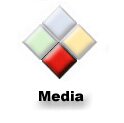|
 Media > Media Elements Media > Media Elements
Media Elements
-
"The capacity for perception depends on the amount,
the kind and the availability of past experiences....
We see familiar things more clearly than we see objects
about which we have no stock of memories."
-
Aldous Huxley
|
Media Elements — such as text, graphics, animation, audio, video, and interactive user interface components — provide communication leverage to achieve organizational development goals.
- Appropriate use of media is essential for presenting effective E-Learning, Knowledge Management and Performance Support solutions
- "Multimedia" is a term that refers to the mixing, synchronizing, or sequencing several media elements together in order to enhance auditory and visual processing of information.
- This section of the website is about media production technique and best practices. In another section of the website we will discuss Delivery System related to the technology intrastructure.
- We say: Media is NOT Delivery System in order to guard against the category error that blurs media production decisions with larger technology infrastructure decisions.
- We say: Media is NOT Instruction in order to guard against the category error that blurs instructional design decisions with media production technique (including aesthetics, cost-management, and technology use decisions). Both professions and lay persons get confused about the array of priorities. A detailed discussion of this issue continues throughout this section of the website, paricularly "Instructional Decisions Regarding Media Selection"
It is important to maintain the distinction between Instructional Methods (techniques) and Instructional Media (presentation-communication aides).
| Instructional Methods |
What instructional techniques are needed to establish the conditions of learning, impart information, and help learners achieve performance outcomes? |
Instructional
techniques include:
|
 Information Display Information Display
 Presentation Presentation
 Demonstration Demonstration
 Practice Exercises Practice Exercises
 Simulation Simulation
 Feedback Feedback
 Prompting / Guidance Prompting / Guidance
 Reinforcement Reinforcement
 All items relate to Gagne's "Nine Events of Instruction" All items relate to Gagne's "Nine Events of Instruction" |
| Instructional Media |
What media will most efficiently and effectively transmit the required instructional methods? |
Media Elements for Instruction include:
 human, human,
 print, print,
and
 electronic electronic |
 Instructor Instructor
(presentation, facilitation, mentoring, peer interaction)
 Computer Computer
(screens, graphics, text, animation, audio, video)
 Printed workbook & books Printed workbook & books
(text, graphics)
 Video & audio Video & audio
(for passive viewing and listening)
 Web-based training tutorials Web-based training tutorials
(emphasizing interactivity)
 And many other media forms And many other media forms |
The relationship between instruction, media and delivery system tasks are illustrated in this flow chart.

The important clarification is that Media is NOT Instruction and Media is NOT Delivery System. While use of Media can be an essential component of instructional or information presentation, the selection and crafting of media use is only one small part of either information presentation or instructional design. There is more to information architecture and instructional strategy than just the use of Media.
In the past, the term "Media" was used synonymously with Delivery System because there were so few options: There were live classroom presentations, textbooks, educational film and television. Today, however, an enterprise's IT infrastructure is a conduit for a range of media providing KM, E-Learning, and Performance Support.
Delivery System issues define the available infrastructure and logistics capability. The list of possible physical and electronic Delivery Systems continues to grow; and each Delivery System modality is typically able to incorporate its own set of interactive multimedia elements. The whole concept of "classroom" is being transformed with the introduction of "virtual classrooms" online, as alternative or augmentations to physical classrooms. Clearly, however, the role of human-to-human interaction is vital and is being preserved by everyone concerned with effective teaching and learning.
The production of Media Elements require certain technology tools. The building and maintenance of Delivery Systems requires a different set of technology tools.

|
|
 |
Media Elements
|
 |
|
|



